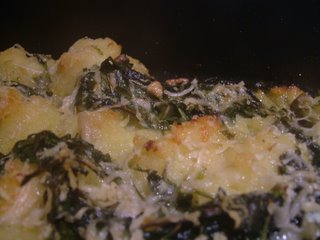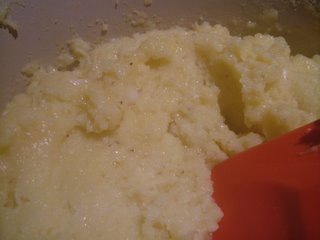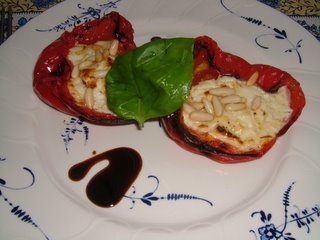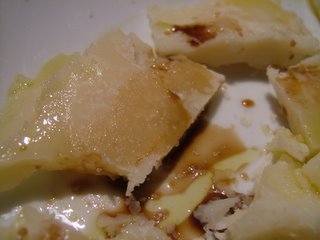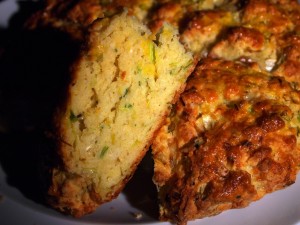 Inspiration comes from funny places, on this occasion Dr W’s nostalgic thoughts about a parmesan and leek scone that Starbucks sold when they first arrived in the UK and we all discovered Frappuccinos and comfy chairs. I remember that scone dimly, and it seems the scone in my imagination and the scone in his are not the same thing at all. The scone I remember was a dry and sad production with not enough cheese, not enough leek, and a miserable little pot of cream cheese to smear inadequately on the cut surface to moisten it. Dr W remembers it as some sort of delicate überscone, a scone of youth and freedom. I love him, so I came up with a scone bread for his dinner that might remind him of the original (not too closely, obviously, because I didn’t like the original much – this one’s much moister and packs a lot more flavour).
Inspiration comes from funny places, on this occasion Dr W’s nostalgic thoughts about a parmesan and leek scone that Starbucks sold when they first arrived in the UK and we all discovered Frappuccinos and comfy chairs. I remember that scone dimly, and it seems the scone in my imagination and the scone in his are not the same thing at all. The scone I remember was a dry and sad production with not enough cheese, not enough leek, and a miserable little pot of cream cheese to smear inadequately on the cut surface to moisten it. Dr W remembers it as some sort of delicate überscone, a scone of youth and freedom. I love him, so I came up with a scone bread for his dinner that might remind him of the original (not too closely, obviously, because I didn’t like the original much – this one’s much moister and packs a lot more flavour).
You shouldn’t need any butter to moisten this scone; it’s very rich. Treat it as a bready accompaniment to go with ham, some hard cheese, chutney and a salad for a quick supper. It’s best served warm from the oven, but it’s terrific cold, and will be great the next day in a lunchbox too. A bread leavened with baking powder like this is great for those who are nervous around yeast, and, because it doesn’t need long periods of proving and rising, is much quicker to make than a yeasty bread too.
To make enough for six portions, you’ll need:
240g plain flour
1 tablespoon baking powder
1 teaspoon salt
100g salted butter
100g leeks, green and white parts
1 tablespoon fresh thyme leaves, picked from stems
75g Parmesan cheese
50g Cheddar cheese
2 large eggs, plus one to glaze
120ml semi-skimmed milk
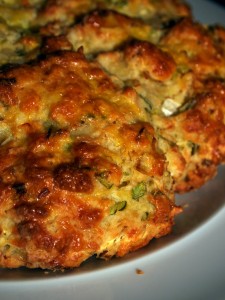 Preheat the oven to 190°C (375°F).
Preheat the oven to 190°C (375°F).
Sieve the flour, salt and baking powder into a large bowl. Cut the cold butter into little pieces in the flour bowl and rub them into the flour with your fingers until the mixture resembles breadcrumbs.
Chop the leek into very small dice and grate the cheeses. Stir the leek, cheese and thyme into the flour and butter mixture.
In a small bowl, whisk two eggs and the milk together. Pour into the dry mixture and use your hands to bring ingredients together gently until you have a ball of dough.
On a greased tray lined with parchment paper, press the ball of dough into a flat, round loaf shape. Beat the egg for glazing and brush it over the surface of the loaf.
Bake for 35 minutes until pale gold. A skewer inserted into the middle should come out clean – if it doesn’t, keep cooking for 5 minutes and check again until the scone bread is done.
When the scone bread is ready, remove it to a cooling rack and leave it for twenty minutes to cool off a little. Slice into six pieces and serve warm.

